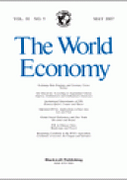How can the African Continental Free Trade Area help Green African Trade?
28 mai 2025

de Melo J., Solleder J-M. (2023) "The Landscape of CO2 Emissions Across Africa: A Comparative Perspective", The World Economy, Special Issue "Supply Chain Trade in Africa: retrospect ans prospect", Edited by de Melo J., Olarreaga M., vol. 46 (11), pp. 3392-3418
